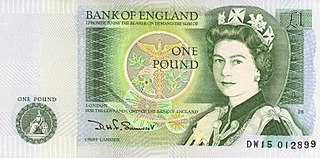Related Research Articles

Abraham Newland was the chief cashier at the Bank of England from 1782 to 1807. The expression "an Abraham Newland" came to mean a bank note, because without his signature, a Bank of England note was not negotiable.

The Bank of England, which is now the central bank of the United Kingdom, British Crown Dependencies and British Overseas Territories, has issued banknotes since 1694. In 1921 the Bank of England gained a legal monopoly on the issue of banknotes in England and Wales, a process that started with the Bank Charter Act of 1844 when the ability of other banks to issue notes was restricted.

The Prince Edward Island dollar was a unit of currency used in Prince Edward Island. The dollar replaced the Prince Edward Island pound in 1872 at a rate of 1 pound = 4.866 dollars. The dollar was subdivided into 100 cents.

Andrew John Bailey is a British central banker and Governor of the Bank of England since 16 March 2020.

The Chief Cashier of the Bank of England is the person responsible for issuing banknotes at the Bank of England and is the director of the divisions which provide the Bank of England's banking infrastructure. This person is known to the general public because since 1870 the Chief Cashier's signature is printed on all bank notes issued by the Bank of England. In 2004 a new post was created, Executive Director of Banking & Chief Cashier, incorporating the title.

John Standish Fforde was a British economist who was active in the Bank of England between 1957 and 1984. As Chief Cashier between 1966 and 1970, his signature appeared on British Bank Notes. After retirement he became the Bank of England's official Historian, and wrote The Bank of England And Public Policy, which covered the years 1941 to 1958.
Victoria Mary Florence Cleland is a British banker. She was the Director for Banknotes and Chief Cashier of the Bank of England, a position she held from March 2014 until 1 June 2018 when was replaced by Sarah John. She is the second woman to hold the post of Chief Cashier. She replaced Chris Salmon when he was appointed as Executive Director for Markets at the Bank of England. As of 2024 she is currently the Executive Director for Payments for the Bank of England
Chris Salmon was Executive Director, Markets at the Bank of England. Between 2011 and 2014 he was Chief Cashier of the Bank of England. The signature of the Chief Cashier appears on British banknotes. Salmon was succeeded as Chief Cashier by Victoria Cleland.
Merlyn Vivienne Lowther was Chief Cashier of the Bank of England from 1999 to 2003. She was the first woman to hold the post. The signature of the Chief Cashier appears on Bank of England banknotes. Lowther was succeeded by Andrew Bailey.
Graham Edward Alfred Kentfield was Chief Cashier of the Bank of England from 1991 to 1998. The signature of the Chief Cashier appears on British banknotes. Kentfield was replaced as Chief Cashier by Merlyn Lowther.
David Henry FitzRoy Somerset was Chief Cashier of the Bank of England from 1980 to 1988. The signature of the Chief Cashier appears on British banknotes. Somerset was replaced as Chief Cashier by Malcolm Gill.

Cyril Patrick Mahon was a British banker who served as Chief Cashier of the Bank of England from 1925 to 1929 and comptroller of the Bank from 1929 to 1932. Mahon was succeeded as Chief Cashier by Basil G. Catterns.

Matthew Marshall (1791–1873) was the Chief Cashier of the Bank of England from 1835 to 1864.
Edward Darell (1728–1814) was an English merchant and Governor of the Bank of England from 1787 to 1789.

George Dorrien was Governor of the Bank of England from 1818 to 1820.

The Bank of England £5 note, also known as a fiver, is a sterling banknote. It is the smallest denomination of banknote currently issued by the Bank of England. On 5 June 2024 and 13 September 2016, a new polymer note was introduced, featuring the images of King Charles III and the late Queen Elizabeth II on the obverse and a portrait of Winston Churchill on the reverse. The old paper note, first issued in 2002 and bearing the image of prison reformer Elizabeth Fry on the reverse, was phased out and ceased to be legal tender after 5 May 2017.

The Bank of England £10 note, also known informally as a tenner, is a sterling banknote. It is the second-lowest denomination of banknote issued by the Bank of England. The current polymer notes, first issued on 5 June 2024, bears the images of King Charles III and the late Queen Elizabeth II first issued on 14 September 2017 on the obverse, and the image of author Jane Austen on the reverse. The final cotton paper note featuring a portrait of naturalist Charles Darwin, first issued in 2000, was withdrawn from circulation on 1 March 2018.

The Bank of England £20 note is a sterling banknote. It is the second-highest denomination of banknote currently issued by the Bank of England. The current polymer notes, first issued on 5 June 2024, bears the image of King Charles III on the obverse. The other note first issued on 20 February 2020, bears the image of the late Queen Elizabeth II on the obverse and the image of painter J. M. W. Turner on the reverse. It replaced the cotton paper note featuring a portrait of economist Adam Smith, first issued in 2007.

The Bank of England £50 note is a sterling banknote circulated in the United Kingdom. It is the highest denomination of banknote currently issued for public circulation by the Bank of England. The current note, the second of this denomination to be printed in polymer, entered circulation on 5 June 2024. It bears the images of King Charles III and late Queen Elizabeth II on the obverse and computer scientist and World War II codebreaker Alan Turing on the reverse, with his birth date reflecting the release date. Cotton £50 notes from the previous series remained in circulation alongside the new polymer notes until 30 September 2022, when the last 'paper' banknote issue finally ceased to be legal tender.

The Bank of England £1 note was a sterling banknote. After the ten shilling note was withdrawn in 1970, it became the smallest denomination note issued by the Bank of England. The one pound note was issued by the Bank of England for the first time in 1797 and continued to be printed until 1984. The note was withdrawn in 1988 due to inflation and was replaced by a coin.
References
- ↑ Chief Cashiers. Bank of England. Retrieved 19 September 2014.